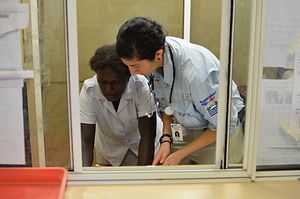In one fell swoop, Australia’s Foreign Minister Julia Bishop has sought to redefine the nature and direction of Australia’s aid policy. Speaking at the National Press Club on June 18, the minister launched a new aid policy and performance framework, which she referred to as the “new aid paradigm.”
Australia’s aid program will have two new principal strategic goals for recipient countries: human development and private sector development. To achieve these, there will be six core priority areas, including infrastructure and trade, agriculture and resource management projects, good governance, education and health, humanitarian assistance, and the empowerment of women. The geographic focus will swing back towards Australia’s immediate region with the government set to invest more than 90 percent of country and regional program funding in the Indo-Pacific region.
The overarching theme of the speech was the central role that economic diplomacy will play in the objectives and delivery of Australian aid. This has been a key policy for the Coalition government since it came to power and a high priority for Bishop in particular, who stressed the importance of economic growth as a means of reducing poverty and improving living standards. While hardly in contention, the difference is perhaps in the emphasis.
The speech outlined an aid program that aimed to be much more economically efficient and rigorous yet one that was also much more limited. “As aid deliverers,” Bishop said, “we should be aiming for aid recipient nations to transform into sustainable economies – do ourselves out of a job, not perpetuating past approaches that are not effective.” She cited the example of Australia’s co-financing of the construction of the Cao Lanh Bridge in Vietnam with the goal of opening up trade and investment along the Mekong Delta. Projects that can reduce such “infrastructure bottlenecks,” she argued, are vital to facilitating job creation, expanding global supply chains and drawing in private investment.
The rhetoric of self-reliance, however, is also borne out of budgetary considerations. The government’s aid budget will be capped at $5 billion after having been cut by $7.6 billion for the next five years. In its place, the government will introduce performance benchmarks and strengthen the assessment of contractors, NGOs and multilateral organisations that deliver Australian aid. “When projects don’t deliver the results we expect,” Bishop warned, “they will be put on a rigorous path to improvement or be terminated.”
At the heart of the “new aid paradigm” will be the creation of a Performance Incentive Fund. The incentive fund, she said, “will offer increased funding for programs and organisations found to be particularly effective in meeting targets and benchmarks.” Australia will also participate in the Global Development Innovation Ventures program, a U.S.-led initiative which aims to test, finance and scale up innovative approaches to international aid and development.
A new Development Innovation Hub will be set up within the Department of Foreign Affairs and Trade (DFAT), hoping to draw on the innovative ideas and creative solutions of the private sector, academia and NGOs. Over four years, $140 million will be provided to the trialling and testing of different development initiatives.
This follows on from the absorption of AusAID, the government agency tasked with administering Australia’s aid program, into DFAT last year and will bring aid more firmly into the department’s economic diplomacy fold. The recent changes suggest that a much higher priority will be placed on creativity and innovation at the policy development stage, but whether the capacity or funding for achieving such goals will be adequate remains to be seen.

































